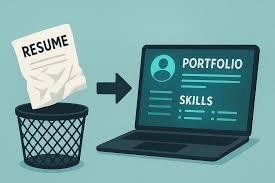
Resumes Are Dead: Why Your Portfolio is the New Currency (Even if You're Not Creative)
Resumes Are Dead: Why Your Portfolio is the New Currency (Even if You're Not Creative)
For decades, the resume has been the gatekeeper of career opportunity. A crisp, one-to-two-page summary of your past roles and responsibilities, it was the required artifact of every job application. Today, however, that parchment is crumbling under the weight of digital reality. In a world saturated with AI-generated text and optimized keywords, the traditional resume has lost its power to prove the single most important thing: what you can actually do.
Enter the professional portfolio.
The portfolio is no longer just for designers and photographers; it is the new currency for every modern professional. It's the proof-of-work that cuts through the noise of generic applications. It moves the conversation from "where you've been" (the resume) to "what value you can create right now" (the portfolio). If you want to land a high-value role in the current market, you must transition from being a resume collector to a portfolio builder.
The Resume’s Fatal Flaw: The 'Tell, Don't Show' Problem
The resume is fundamentally a document of declaration: I am strategic. I am a leader. I am proficient in Excel. These are assertions that a hiring manager can easily doubt, especially when every other candidate makes the same claims.
-
It's Generic: The need to pass an Applicant Tracking System (ATS) forces candidates to use sterile keywords, making every resume look and sound the same.
-
It’s Passive: It speaks in the past tense, listing responsibilities rather than showcasing impact. For example: "Managed a social media campaign" tells you nothing about the quality of the work.
-
It Lacks Context: It can’t show the complexity of a project, the elegance of a solution, or the specific communication style that makes you valuable.
A portfolio, by contrast, is a document of demonstration. It’s the artifact of your effort, providing objective evidence that turns your assertions into facts.
The Portfolio is for Everyone: Beyond the Creative Fields
The most common misconception is that portfolios are only relevant for "creative" careers—graphic design, writing, or video production. This couldn't be further from the truth. In the digital economy, every knowledge worker produces artifacts that can be showcased.
| Traditional Role | Resume Claim | Portfolio Proof (Artifact) |
| Project Manager | "Strong organizational and planning skills." | Project Artifact: A redacted project plan, a Gantt chart, a communication strategy document, or a post-mortem report from a successful launch. |
| Sales/Business Dev. | "Proven track record in closing deals." | Project Artifact: A sample pitch deck, a one-sheet on a successful client acquisition strategy, or a testimonial video. |
| Data Analyst | "Proficient in Python and data visualization." | Project Artifact: A public GitHub repository with commented code, a Tableau or Power BI dashboard linked via a screenshot, or a one-page executive summary of a personal data analysis project. |
| Human Resources (HR) | "Developed effective training programs." | Project Artifact: A sample presentation deck from a training session, a revised employee onboarding document, or an internal communications plan for a change management initiative. |
If your job involves strategizing, analyzing, communicating, or solving problems, you have work you can showcase. Your portfolio is a curated collection of your solutions.
Building Your Digital Currency: The Portfolio Blueprint
Building an effective professional portfolio requires strategic curation, not simply dumping files online.
1. Choose Your Platform (Keep it Simple)
You don't need to be a web developer. Simple, professional platforms are the most effective:
-
LinkedIn: Use the "Featured" section to link to external projects, PDFs, and presentations. It’s highly visible.
-
Notion or Google Sites: Free, easy to use, and excellent for structuring case studies and displaying documents.
-
GitHub/Medium: Ideal for technical (code) or writing-heavy roles.
2. Curate Quality Over Quantity
An excellent portfolio contains your best 3 to 5 projects. Each project should be presented as a case study using the STAR method (Situation, Task, Action, Result).
-
Situation: What was the problem or challenge? (E.g., "The client was struggling with low engagement on their social media platform.")
-
Task: What was your goal? (E.g., "My goal was to increase engagement by 25% over three months.")
-
Action: What specific, measurable steps did you take? (E.g., "I developed a new content pillar focused on short-form video tutorials and implemented a segmented email strategy.")
-
Result: What was the outcome? (This is the most critical part.) (E.g., "Engagement increased by 32%, and we saw a 10% lift in lead generation.")
3. Address Confidentiality (The Redaction Strategy)
Many professionals worry about sharing proprietary work. The solution is simple: redact and anonymize.
-
Use Placeholder Data: Change client names, dollar amounts, and specific product names to generic, non-identifiable terms (e.g., "Mid-sized Tech Client," "$X million," "Product Y").
-
Focus on the Process: Showcase the methodology, the strategy, the wireframes, and the thought process, not the final, confidential deliverable. A hiring manager cares more about how you solved the problem than who the client was.
4. The "Ideal Candidate" Project
If you have minimal professional experience, create a spec project (a speculative project). This is a perfect way to demonstrate your skills.
-
Example: If you want an HR role, propose a new employee benefits package for a hypothetical company and create the internal memo to roll it out.
-
Example: If you want a finance role, analyze a public company’s last quarterly report and present your findings on their liquidity.
The spec project shows your initiative, your ability to think critically about an industry problem, and your current skills—all without needing prior experience.
The New Interview Experience
When you submit a portfolio link alongside your resume, the interview dynamic changes immediately.
Instead of answering vague behavioral questions like, "Can you tell me about a time you handled a difficult stakeholder?", you guide the interviewer directly to your proof: "I'd be happy to. If you look at Case Study #2 in my portfolio, you can see the detailed communication plan I developed to manage the launch of that product, which involved three competing departments..."
The portfolio turns a potentially stressful evaluation into a guided discussion about your successful track record. It transforms you from a generic applicant into a demonstrated problem-solver—and that is the currency of choice in the modern job market. Resumes may be dead, but proof of your potential is more valuable than ever.
FAQs on Portfolio Building
1. How long should my portfolio take to build? You can create a basic, effective portfolio in a single focused weekend. Since you are only curating your best 3-5 existing projects, the main task is documenting them with clear case study narratives. Continuous maintenance should take only a few hours per quarter as you complete new work.
2. Where should I put the portfolio link on my resume?
The link should be prominently featured in the header section, right alongside your phone number, email address, and LinkedIn URL. Use a clean, simple URL (e.g., a link to your Google Site or Notion page). Make it instantly clickable and professional.
3. What if all my previous work is confidential?
Focus on the process and the impact, not the specifics. Create redacted versions of documents. Use bar charts or graphs to show percentage increases (without specific revenue numbers). Describe the methodology you used for a successful strategy (e.g., "Utilized A/B testing on five different campaign creatives") rather than showing the proprietary creative itself. Your process is the most valuable, non-confidential asset you possess.




